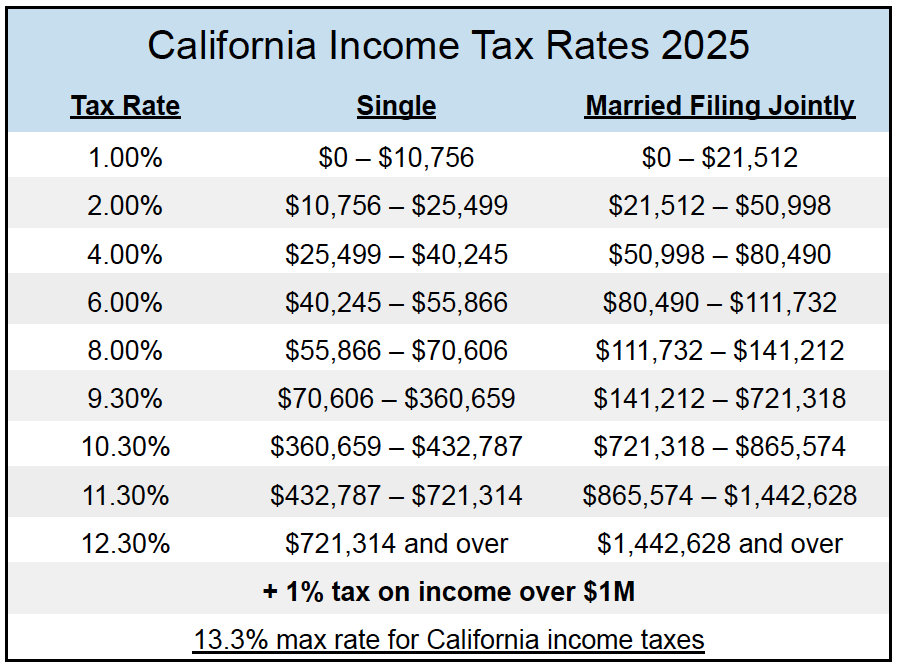Choosing a Withholding Election for NVDA RSUs
Nvidia now lets employees who receive restricted stock units (RSUs) choose to withhold at non-standard rates for Federal and California income tax.
This is important because it’s sometimes hard to avoid underpayment penalties in California if you make over $1M in income from all sources.
This article will briefly cover why this withholding election is important, what withholding choices you have, how to determine your selection, as well as a few other considerations for managing your Nvidia RSUs.
Table of Contents ▼
Why Your Withholding Election is Important at Nvidia
Simply put, choosing the right withholding election helps you avoid tax penalties and also helps ensure that you’re not caught off guard by a large tax bill.
Typically and historically, companies are required to withhold some level of taxes when employees’ RSUs vest.
For Federal income taxes, companies typically withhold from RSUs at 22% until $1M of RSU income, then 37% from $1M onward.
For California income taxes, the standard statutory rate for RSUs is 10.23% and typically doesn’t change.
Nvidia, being the cool company that it is, provides California employees with the ability to withhold at a rate of their choosing for California income taxes.
Nvidia further illustrating its coolness, recently announced that employees can opt to withhold at 37% immediately vs the 22% to 37% progression.
This means that it is up to Nvidia employees to think a little strategically about their taxes and their Nvidia equity.
Quick Example of Tax Withholding Pain Points
Let's say you had a taxable income of $5M between your salary and RSU income.
Throughout the year you had the following withheld from your salary, bonuses, and RSUs:
$1.5M for Federal income taxes
$450k for California income taxes
It’s now April, and your CPA tells you that you owe an additional:
$250k for Federal income taxes
$170k for California income taxes
If you weren’t expecting this level of additional tax, you’re in for a not-so-fun surprise.
And what makes it even worse is that at this level of income, there are probably penalties being assessed on the California taxes owed because not enough was withheld throughout the year.
Of course, even if you’re not at this level of income, being surprised by any additional taxes or penalties is a major annoyance.
Withholding Choices for RSUs at Nvidia
For Federal taxes, Nvidia employees can choose to withhold at either of the following:
22% until $1M, then 37% (standard rate)
37% always
For California taxes, Nvidia lets employees choose to withhold at the following rates as long as they communicate that choice in advance:
10.23% (standard rate)
11.33%
12.43%
13.53%
14.63%
It may not seem like much, but the addition of these withholding rates can be really beneficial if you receive NVDA RSUs.
Determining Your Withholding Choice for NVDA RSUs
Since you can now elect to change both your Federal withholdings and California withholdings, there’s a little bit of extra work to evaluate appropriately. Here are the three steps we recommend to help you determine which option to select.
Step 1 - Acquaint Yourself with Federal & California Income Tax Brackets
The first thing you’ll want to do is get familiar with income tax brackets so you can roughly place yourself in the right bracket.
For Federal income taxes and determining whether to do the standard progression or straight 37%, we’ve built the following Withholding Comparison Calculator for you to use.
For California income tax rates, we’ve provided a chart below so you don’t have to go looking for them:
By looking at this chart of income tax rates, you can identify roughly where you might fall.
It’s important to mention that California’s tax system is progressive (just like Federal taxes).
This means that as you make more money, each new dollar of income either inches towards a higher tax rate, or is taxed at a higher tax rate (until you eventually reach the max rate).
It’s also important to mention that California doesn’t have any special income tax rates for capital gains or interest. Income is income.
You may be wondering why Nvidia has a higher withholding percentage available than the top California income tax rate. That’s a great question. Our guess is that it’s simply an additional buffer. (California has a 1.1% State Disability Insurance requirement, but that is separate from income taxes and is withheld from RSUs and salary regardless of the election choice.)
Step 2 - Understand Potential Trade-offs
When selecting your withholding percentage, it’s important you take time to think about the pros and cons of your decision.
Pro #1 - The biggest pro of selecting a higher withholding percentage on your NVDA RSUs is that it can remove all worries about taxes as it relates to your NVDA RSUs. If you select 37% and 14.63%, you can safely assume that your RSUs won’t be the cause of additional taxes owed to the state. (Though other things could still cause extra taxes.)
Pro #2 - Another pro of selecting a higher withholding rate is that it will reduce the likelihood of being under-withheld and incurring penalties.
Pro #3 - Withholding at a higher rate essentially forces you to sell Nvidia stock. It’s always a chore to log in to Schwab and sell shares, so by withholding a higher amount, it helps reduce some of the “action friction” by doing it for you.
Con #1 - The big con of withholding at a higher percentage is that it means that you will have to give up Nvidia stock. Nvidia is widely known as the first $4 trillion company, and its stock is considered pretty desirable. If you withhold at higher amounts, yes, your tax worries will be less, but you may also miss out on some pretty substantial gains.
That said, you will still benefit from the appreciation of all your other unvested RSUs. That’s why we think withholding at a higher rate is often the best option. Although it can be painful to give up stock, it does ensure that your tax payments will be covered.
It’s important to remember that stocks don’t always go up, and if you’re relying on the sale of future stock to cover tax payments, it can really hurt if the stock price drops and you’re forced to sell at an inopportune time.
Step #3 - Dive Into Your Tax Details
If you can know exactly what bracket you’re going to be in in a given tax year, then it’s easier to figure out what tax rate to withhold at. The problem with RSUs (especially NVDA RSUs) is that your income could be vastly different over the course of a few months due to stock appreciation (or stock depreciation).
We run current-year tax projections for our Nvidia clients, which allows for greater tax awareness and for better recommendations for a good withholding rate.
We like to look at both the prior year’s tax return and annualize the current year’s income data so we get a sense of how we’re tracking. Our article on how to avoid California underpayment penalties describes this process in detail.
What Withholding Choice Should You Make on Your NVDA RSUs?
Since so many of you are in the highest tax brackets or are approaching the highest tax brackets, it often makes sense to select 37% for Federal and the 13.53% or the 14.63% option for California.
If you haven’t had to deal with tax annoyances before, it might seem crazy to voluntarily choose a higher withholding percentage, but the reality is that it will save you the stress of worrying about how much you’re going to owe at tax time.
Other Considerations for Your Nvidia RSUs
We’ve previously written about how to manage your NVDA RSUs and have also written about Nvidia’s ESPP. Since we’ve been discussing Nvidia RSUs in this article, we thought we’d also include a few quick tips for making the most of them.
Tip #1 - Figure Out a Long-Term Plan
Nearly every Nvidia client we have recognizes that Nvidia is a good place to work, but many didn’t realize just how life-changing the experience would become.
We encourage you to take some time to really think about what’s important to you and what you’d like to accomplish with the wealth you’ve accumulated thanks to being at Nvidia.
And once you’ve given it some thought, make a plan to make those important things happen.
Flat fee advisors like us are helpful for mapping decisions out and putting this analysis together. If you’d like to see a sample of our work, just send us a quick email at team@equityftw.com.
Tip #2 - Don’t Be Afraid to Pay Taxes
Just a little word of caution: Salespeople know to target you. The longer you’ve worked at Nvidia, the wealthier you’ve likely become, and the bigger the target they may find you.
These salespeople will often pitch you on different ideas to save money on taxes. Some are fine. Some are probably fine. Some aren’t worth the hassle. And some are outright dangerous.
If you haven’t ever diversified anything from your Nvidia holdings, it’s often best just to pay your taxes and shore up your finances.
We’ve found that paying your taxes and investing broadly is often the simplest and wisest thing you can do. Remember, simple can be extremely powerful!
Tip #3 - Selling Always Feels Bad
No employee wants to part ways with their precious Nvidia stock. We totally get it.
If we knew the future, we could tell you exactly what would happen with Nvidia and exactly when you should sell.
The problem is that we don’t know. And there is no way of knowing for sure.
What we do know is that investing in 3000+ companies results in less company-specific risk and has been a proven strategy over the last 100+ years.
Becoming comfortable with selling Nvidia shares oftentimes requires going through Tips #1 and #2.
If you’ve gone through both, you’re now in a better position to calculate just how much value from Nvidia you need to extract to set yourself up for the future.
Final Thoughts on the Withholding Election at Nvidia
It was probably obvious as you were reading, but we often like the idea of withholding at slightly higher rates simply because it reduces tax stress and removes the need to remember to sell additional shares to cover taxes.
Regardless of the decision you make, it should be made only after careful consideration and in coordination with a broader financial plan.
If you’re interested in working with us, we encourage you to check out our services page and book an intro call.
EquityFTW is unique in the sense that we work for a flat fee, versus requiring management of assets. We do this because we believe it reduces any potential conflicts of interest. Our goal is simply to help you make the most of your equity. That’s it.
As always, thanks for reading!



